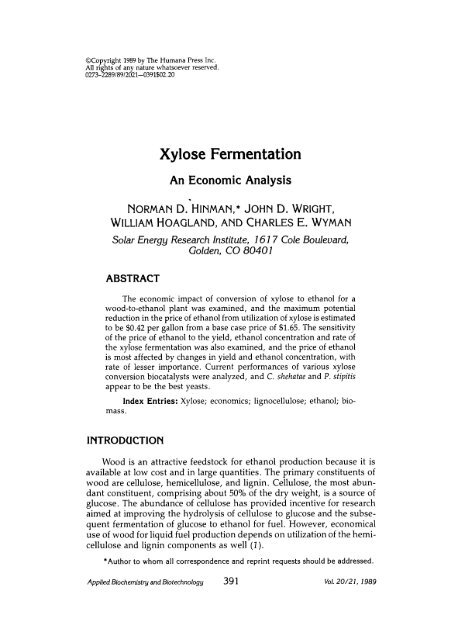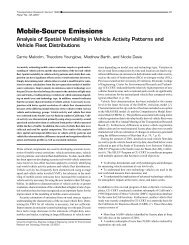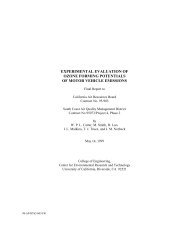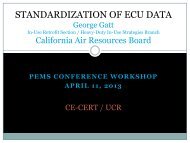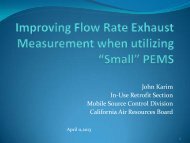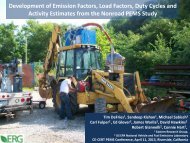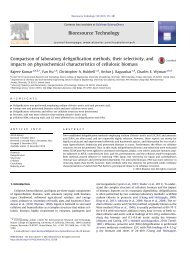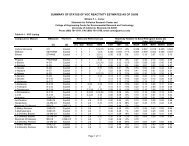Xylose fermentation - ResearchGate
Xylose fermentation - ResearchGate
Xylose fermentation - ResearchGate
You also want an ePaper? Increase the reach of your titles
YUMPU automatically turns print PDFs into web optimized ePapers that Google loves.
<strong>Xylose</strong> Fermentation 393~'~I o~ I----~~ >( I:= I I'~ '1 !~.~-2~ 8~'~@~ ~ .o~ .~ .~~.o~rnm~o~o• .~ ~o~| ~9 ~ ~lO..~,~.oO00n~'-~• 2.~~ .~ .~ .~.~o~.~ ;2~'~ ''~00Applied Biochemistry and Biotechnology Vol. 20/21, 1989
<strong>Xylose</strong> Fermentation 395Table 1Annual Operating and Capital Charges (cents/gallon of ethanol produced)for the Base Case Wood-to-Ethanol Process aCent/galRaw materialsWood 70.38Sulfuric acid 2.16Lime 1.16Chemicals 1.72UtilitiesWater 0.75Steam 0.00Labor 6.62Overhead and maintenance 31.46ByproductsFurfural 0.00Lignin 0.00Electricity - 4.62Annual operating cost 109.63Capital charges 55.41165.04aFor this case, cellulose is converted to ethanol but xylose is not converted.model was used to calculate material and energy balances, operating costs,and ethanol selling price.The design presented should not be viewed as that from a real operatingplant but as our best estimates of current technology. The modelaccurately reflects the sensitivity of the process to the key parametersassociated with the xylose conversion unit, but uncertainty in the basicdesign means that the absolute ethanol selling price cannot be accuratelyestimated. Therefore, although great care was exercised in preparing themodel and economics, caution must be used when comparing the resultsof this study to other authors who may have used different cost estimating,economic methodologies, or other technologies.RESULTSMaximum Economic EffectCaused by <strong>Xylose</strong> ConversionFor the base case, in which none of the xylose is converted to ethanol,the price of ethanol is $1.65/gallon. The annual operating costs and annualcapital charge for this case are shown in Table 1. The cost of enzyme(s) isnot included in the chemicals cost. Rather, it is contained in the capitaland operating costs of the enzyme production unit(s).Applied Biochemistry and Biotechnology Vol. 20/21, 1989
396 Hinman et al.The economic effect of xylose conversion depends on three key xyloseconversion parameters: yield, ethanol concentration, and productivity.The highest yield obtainable is 100% theoretical or 0.51 gm of ethanol pergm of xylose. In addition, the highest ethanol concentration attainable inthe xylose conversion unit from a 6% xylose feed is 3% ethanol. Furthermore,for a given yield, the xylose conversion capital cost per annualgallon of ethanol produced from xylose is a function of productivity, andfor this study, the capital cost per annual gallon for high productivityvalues was found to have a minimum value of $0.25/annual gallon. Accordingly,the maximum potential reduction in the price of ethanol wascalculated using yield at 100% theoretical, ethanol concentration at 3%,and capital cost per annual gallon at $0.25. Using these values, the priceof ethanol with xylose conversion is $1.23/gallon, which represents a$0.42/gallon or 25% reduction in the price of ethanol from the base case.Economic Effectof Using Current <strong>Xylose</strong> Conversion BiocatalystsValues for the three key parameters that are associated with variouscurrent xylose conversion biocatalysts were obtained from the literature(yeast (11-35); fungi (32,36-40); bacteria (4,41-44); xylose isomerase-yeast(45-47). All values were for batch <strong>fermentation</strong>. If the <strong>fermentation</strong> time,or volumetric productivity, was not given, the <strong>fermentation</strong> time wasassumed to be 4 d. (As will be discussed in the next section, xylose <strong>fermentation</strong>time has a minimal effect on the price of ethanol and the valueassumed is not critical.) The ethanol prices calculated for each set of performanceparameters associated with a given type of biocatalyst wereaveraged to obtain a representative ethanol price for the biocatalyst type.In addition, a representative ethanol price was calculated for certain biocatalysttypes using only performance data where the initial xylose concentrationwas close to 60 gm/L, which is the undiluted xylose concentrationin the feed to the xylose conversion unit in this study. These latter pricesdid not differ significantly from those calculated from all available performancedata.A considerable amount of performance data exists for three types ofxylose fermenting yeasts, i.e., P. tannophilus, C. shehatae, and P. stipitis.Representative ethanol prices associated with the use of these yeasts areshown in Fig. 2. For C. shehatae, the representative price is $1.36 per gallon,for P. stipitis the price is $1.37 per gallon, and for P. tannophilus the price is$1.48. Thus, C. shehatae and P. stipitis perform better than P tannophilus.Moreover, the ethanol price for C. shehatae and P. stipitis represents areduction in the price of ethanol from the base case of $0.29-$0.30 pergallon, which is 70% of the maximum potential reduction of $0.42 pergallon. The average performance parameters for C. shehatae were yield at70%, ethanol concentration at 2.7%, and a <strong>fermentation</strong> time of 6.7 d. Performancedata for other yeasts is scanty, but none of those yeasts performedbetter than the average performance of C. shehatae or P. stipitis.Applied Biochemistry and Biotechnology Vol. 20/21, 1989
<strong>Xylose</strong> Fermentation 3971.70 -Basecase1.65Bacteria1.60 -SFIXAmt~011.50 -1.48Yeastsv00Fungim0Pt~J=I, Li1.40 -1.30 -01.36I 1.37IiN\NNNNN\NNNNNNN\NNN\NN\ N1.20Fig. 2. Price of ethanol for cases examined in this study. For all cases,cellulose is converted into ethanol. For the base case, no xylose is converted toethanol. For the maximum potential case, xylose is converted to ethanol usingthe following performance parameters: 100% yield, no ethanol inhibition, andhigh productivity. For the remaining cases, xylose was converted to ethanolwith published performance parameters for each type of biocatalyst. The pricesof ethanol shown for each of the yeasts are the average prices calculated forthese biocatalysts. For fungi, bacteria, and the xylose isomerase-yeast combination(SFIX), the range of calculated ethanol prices is shown.Data for fungi, bacteria, and the xylose isomerase-yeast combinationis limited and, therefore, it is difficult to assess their economic performancewith the same degree of confidence as can be done with yeasts.The range of ethanol prices calculated for these types of biocatalysts isshown in Fig. 2. In general, the data for these biocatalysts does not suggestthat they are currently capable of either attaining or surpassing theperformance of the best yeasts.Applied Biochemistry and Biotechnology Vol. 20/21, 1989
398 Hinrnan et al.Sensitivity of Ethanol Priceto Changes in Key <strong>Xylose</strong> Conversion ParametersThe sensitivity of the price of ethanol to changes in the three key xyloseconversion performance parameters was examined in order to develop arationale for future work aimed at improving xylose conversion biocatalysts.The percent theoretical yield was varied between 20-100%. For agiven yield, the maximum allowable ethanol concentration was variedbetween the maximum possible for the yield and lower values by varyingthe amount of dilution water added to the 6% xylose feed stream. Therange of maximum allowable ethanol concentration was 1-3%, with 3%being the highest that can be achieved with the 6% xylose feed stream.The capital cost per annual gallon is a function of <strong>fermentation</strong> time,which, for a given yield and equipment configuration, is a function ofvolumetric productivity. The capital cost per annual gallon for a conversionplant that includes a xylose isomerase unit and that for a plant withoutthe enzyme unit varies between about $0.25-$1.00 for reasonable <strong>fermentation</strong>times. Accordingly, in this study, the xylose conversion capital costper annual gallon of ethanol from xylose was varied between $0.25-$1.00.It was found that changes in the capital cost per annual gallon haverelatively minimal impact on the price of ethanol. A fourfold improvementin capital cost per annual gallon from $1.00 to $0.25 reduces theprice of ethanol $0.05 per gallon. On the other hand, changes in yield andethanol concentration have a major impact on the price of ethanol. Theeffects of changes in the yield and ethanol concentration on the price ofethanol (with capital cost per annual gallon set at $0.25) are shown in Fig.3. This figure shows that a fourfold improvement in yield from 20% to80% at 3% ethanol concentration reduces the price of ethanol by $0.20 pergallon and a threefold improvement in ethanol concentration from 1% to3% at 100% yield reduces the price of ethanol $0.35 per gallon.DISCUSSIONThis study has shown that for the wood-to-ethanol plant described,conversion of xylose to ethanol in a batch system results in a maximumreduction in the price of ethanol of $0.42 from a base case cost of $1.65 pergallon, which is a 25% reduction. The current performance of variousxylose conversion biocatalysts were also analyzed. Of the xylose fermentingyeasts, P. stipitis and C. shehatae appear to be best, since they are currentlycapable of achieving 70% of the maximum possible ethanol pricereduction. To equal this performance, other types of biocatalysts musthave a yield of about 70% and be capable of producing an ethanol concentrationof about 2.7%. Data for fungi, bacteria, and the xylose isomeraseyeastcombination is limited and, therefore, it is difficult to assess theirApplied Biochemistry and Biotechnology Vol. 20/21, 1989
<strong>Xylose</strong> Fermentation 399S\mmoo~JII1.23~ ,.,10.0rcent'~'//) 30.0 ]uu.... JreticalyieldFig. 3. Ethanol price as a function of key xylose conversion parameters.The xylose conversion capital cost is set at $0.25 per annual gallon of ethanolfrom xylose.economic performance with the same degree of confidence as can bedone with yeasts. However, at present they do not appear to be capableof attaining or surpassing the performance of the best yeasts.The three key parameters associated with xylose conversion that impactthe economics of a wood to ethanol plant are yield, ethanol concentration,and productivity. This study has shown that yield and ethanolconcentration are the most important, whereas productivity has a relativelyminor impact. Yield has importance because at a given wood feedrate, each increase in yield translates directly into an increase in revenue.Allowable ethanol concentration has importance because if the allowableconcentration is not high enough, it is necessary to add dilution waterto the feed stream to the xytose conversion unit in order to achieve themaximum potential yield. Unfortunately, whereas the addition of waterpermits the maximum potential yield to be achieved, addition of water increasesthe size of SSF, distillation, the concentration unit, and the wasteApplied Biochemistry and BiotechnoJogy Vol. 20/2 t, 1989
400 Hinman et al.treatment unit. Moreover, the load on the utility systems also increases.Productivity is of minor importance because it only impacts the size of thexylose conversion unit, which is a relatively small percentage of the totalcapital cost of the plant. Given the relative effects of the three parameterson the price of ethanol, it seems clear that future work aimed at improvingxylose conversion biocatalysts should focus on improving yield andethanol tolerance with less emphasis on improving productivity.ACKNOWLEDGMENTSThis work was supported by the Biochemical Conversion Program ofthe US Department of Energy's Biofuels and Municipal Waste TechnologyDivision under FTP No. 658.REFERENCES1. Wright, J. D. (1987), AIChE National Meeting, Minneapolis, MN.2. Jefferies, T. W. (1985), Trends Biotechnol. 3(8).3. Suihko, M-L., and Enari, T-M. (1981), Biotechnol. Lett. 3(12).4. Schmid, U., Giesel, H., Schoberth, S. M., and Sahm, H. (1986), Syst. Appl.Microbiol. 8(1-2).5. Jefferies, T. W. (1981), Biotechnol. Bioeng. Symp. (11).6. Toget, R. W., Himmel, M. E., Wright, J. D., and Grohmann, K. (1987),Ninth Symposium on Biotechnology for Fuels and Chemicals.7. Badger Engineers, Inc. (1984), SERI subcontract ZX-3-030-96-Z.8. Raphaell Katzen and Associates (1978), US DOE Contract No. EJ-78-C-01-6639.9. Wright, J. D., Wyman, C. E., and Grohmann, K. (1987), Ninth Symposiumon Biotechnology for Fuels and Chemicals.10. ICARUS Corp. (1987), Cost Systems User's Manual.11. Slininger, P. J., Bolen, and P. L. Kurtzman (1987), EnzymeMicrob. Technol. 9.12. Dekker, R. F. H. (1982), Biotechnol Lett. 4, 7.13. Leonard, R. H. and Hajny, G. J. (1945), Ind. Enging. Chem. Analyt. Edn. 37.14. Lee, Y. Y. and McCaskey, P. A. (1983), TAPPI 66.15. Clark, T., Wedlock, N., James, A. P., Deverell, K., and Thornton, R. J.(1986), Biotechnol. Lett. 8(11).16. Detroy, R. W., Cunninham, R. L., Bothast, R. J., Bagby, M. O., and Herman,A. (1982), Biotech. Bioeng. 24.17. Slininger, P. J., Bothast, R. J., van Cauwenberge, J. E., and Kurtzman, C. P.(1982), Biotechnol. Bioeng. 24(2).18. Jeffries, T. W., Fardy, J. H., and Lightfoot, E. N. (1985), Biotechnol. Bioeng.27(2).19. du Preez, J. C., Prior, B. A., and Monteiro, A. M. T. (1984), Appl. Microbiol.Biotechnol. 19(4).20. Schvester, P., Robinson, C. W., and Moo-Y6ung, M. (1984), Biotechnol. andBioeng. Syrup. (13).Applied Biochemistry and Biotechnology Vol. 20/21, 1989
<strong>Xylose</strong> Fermentation 40121. Lee, H., James, A. P., Zahab, D. M., Mahmourides, G., Maleszka, R., andSchneider, H. (1986), Appl. Environ. MicrobioI. 51(6).22. Slininger, P. J., Bothast, R. J., Okos, M. R., and Ladisch, M. R. (1985), Biotechnol.Lett. 7(6).23. du Preez, J. C., Bosch, M., and Prior, B. A. (1986), Appl. Microbiol. Biotechnol.23(3-4).24. du Preez, J. C. and van der Walt, J. P. (1983), Biotechnol. Lett. 5(5).25. Jefferies, T. W. (1985), Proceedings of the National Meeting on BiomassR&D for Energy Applications, Elsevier.26. du Preez, J. C. and Prior, B. A. (1985), Biotechnol. Lett. 7(4).27. Prior, B. A. (1987), Seminar given at the Solar Energy Research Institute.28. Delgenes, J. P., Moletta, R., and Navarro, J. M. (1986), Biotechnol. Lett. 8(12).29. Dellweg, H., Rizzi, M., Methner, H., and Debus, D. (1984), Biotechnol. Lett.6(6).30. Morikawa, Y., Takasawa, S., Masunaga, I., and Takoyama, K. (1985), Biotechnol.Bioeng. 27(4).31. Ueng, P. P. and Gong, C. S. (1982), Enzyme Microb. Technol. 4.32. Margaritis, A. and Bajpai, P. (1982), Appl. Environ. Microbiol. 44(5).33. Cong, C. S., McCracken, L. D., and Tsao, G. T. (1981), Biotechnol. Lett. 3.34. Nigam, J. N., Margaritis, A., and Lachance, M. A. (1985), Appl. Environ.Microbiol. 50(4).35. Beck, M. J. and Strickland, R. C. (1984), Biomass, 6.36. Antonopoulos, A. A. and Wene, E. G. (1987), Argonne National Laboratory.Prepared for the Solar Energy Research Institute.37. Suihko, M. L. (1984), Technical Research Center of Finland, Tech. Res.Cent. Final Publ. 0(17).38. Schnider, H., Maleszka, R., Wang, P. Y., Veliky, I. A., and Chan, Y. K.(1984), US Patent No. 4477569.39. Batter, T. R. and Wilke, C. R. (1977), Report LBL-6351 (US DOE)40. Wu, J. F., Lastick, S. M., and Updegraff, D. M. (1986), Nature 321.41. Schepers, H. J., Bringer-Meyer, S., and Sahm, H. (1987), 2. Naturforsch SectC. Biosci. 42(4).42. Patel, G. B. (1984), Appl. Microbiol. Biotechnol. 20(2).43. Patel, G. B., Mackenzie, C. R., and Agnew, B. J. (1986), Arch. Microbiol.146(1).44. Rosenberg, S. L., Batter, T. R., Blanch, H. W., and Wilke, C. R. (1981),AIChE Symp. Ser. 77.45. Hahn-Hagerdal, B., Berner, S., and Skoog, K. (1986), Appl. Microbiol. Biotechnol.24(4).46. Wang, P. Y., Johnson, B. F., and Schneider, H. (1980), Biotechnol. Lett. 2(6).47. Chiang, L. C., Hsiao, H. Y., Ueng, P. P., Chen, L. F., and Tsao, G. T. (1981),Biotechnol. Bioeng. Syrup. (11)..Applied Biochemistry and Biotechnology Vol. 20/21, 1989


